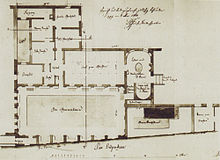Sophienbad (Leipzig)

The Sophienbad in Leipzig was a privately operated bathing establishment with the first indoor swimming pool in the city.
location
The bathroom was on the back of the property at Dorotheenstrasse 3. Dorotheenstrasse has been called Otto-Schill-Strasse since 1912. It was created during the development of Reichels Garten (previously Apels Garten ). The property borders directly on the Pleißemühlgraben . Today the car park Martin-Luther-Ring is located here .
history
The Sophienbad was established in 1863 as an institution for shower and bath tubs. The name probably goes back to the tenant of the Petersbrunnen Sophie Christiane Gebhard, who had already initiated a bathing establishment on her property in Reichel's garden years before. Just six years after the opening of the Sophienbad, its owner Moritz E. Loricke decided to expand it with a year-round heated swimming pool. The architect Moritz Münch, who had also built the bathtub, was responsible for design and execution. This made the Sophienbad the first indoor swimming pool in the city and the fourth in Germany.
In 1883 a gymnasium and playground was built next to the swimming pool. The bath was operated until 1921. Then it had to close because the technical equipment was worn out and no longer met the latest requirements. The new owner of the property had the swimming pool, the bath house and the boiler house with the chimney torn down in 1922. In 1928 a warehouse and sales branch for furniture was established there. Today the entire area is taken up by the parking garage.
Facility
The swimming pool had the small dimensions of 15.97 × 6.94 meters and was up to 2.83 meters deep. It was laid out with marble and was filled with heated river water from the Pleißemühlgraben. The water temperature was 22.5-25 ° C. If the river water was too cloudy, tap water was used. The pool had two 1-meter diving boards and was divided into swimmer and non-swimmer areas. The steam engine for the water pumps also moved a concealed wave wheel, with which the water was given a wave-like movement. The hall had gas lighting and could therefore be opened all year round from 7 a.m. to 9 p.m. Most of these fourteen hours a day belonged to the men. The ladies had two hours of bathing time in the mornings three days a week and three and a half hours in the afternoons on three days.
The bath had twelve first class cell baths with marble tubs, four of which were family cells with two tubs and nine second class cell baths with zinc tubs, one of which had two tubs. In addition, there was a first and second class shower room as well as Russian and Roman-Irish steam baths, medical baths and heated laundry-drying rooms.
literature
- Förderverein Sächsisches Sportmuseum Leipzig eV (Hrsg.): Leipzig goes swimming - from Pleißestrand to Neuseenland. PRO LEIPZIG 2004, ISBN 978-3936508062 , pp. 112/113
- Peter Schwarz: The millennial Leipzig , Volume 2, PRO LEIPZIG 2014, ISBN 978-3-945027-05-9 , p. 337
- Horst Riedel: Stadtlexikon Leipzig from A to Z . PRO LEIPZIG, Leipzig 2005, ISBN 3-936508-03-8 . P. 37
Web links
Individual evidence
- ↑ Gina Klank, Gernot Griebsch: Lexikon Leipziger Straßeennamen , Verlag im Wissenschaftszentrum Leipzig, 1995, ISBN 3-930433-09-5 , p. 20
Coordinates: 51 ° 20 ′ 16.1 ″ N , 12 ° 22 ′ 11.8 ″ E

